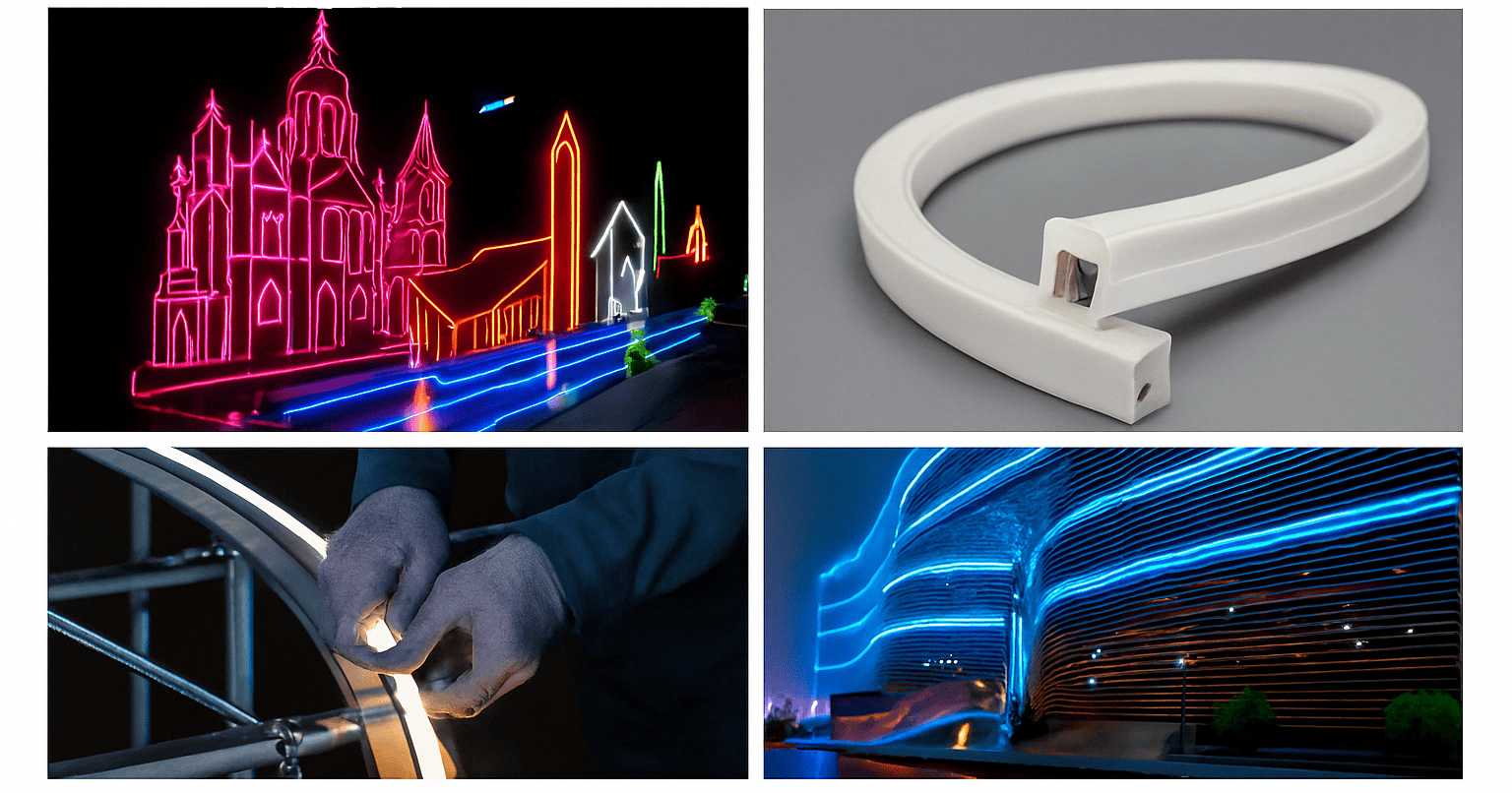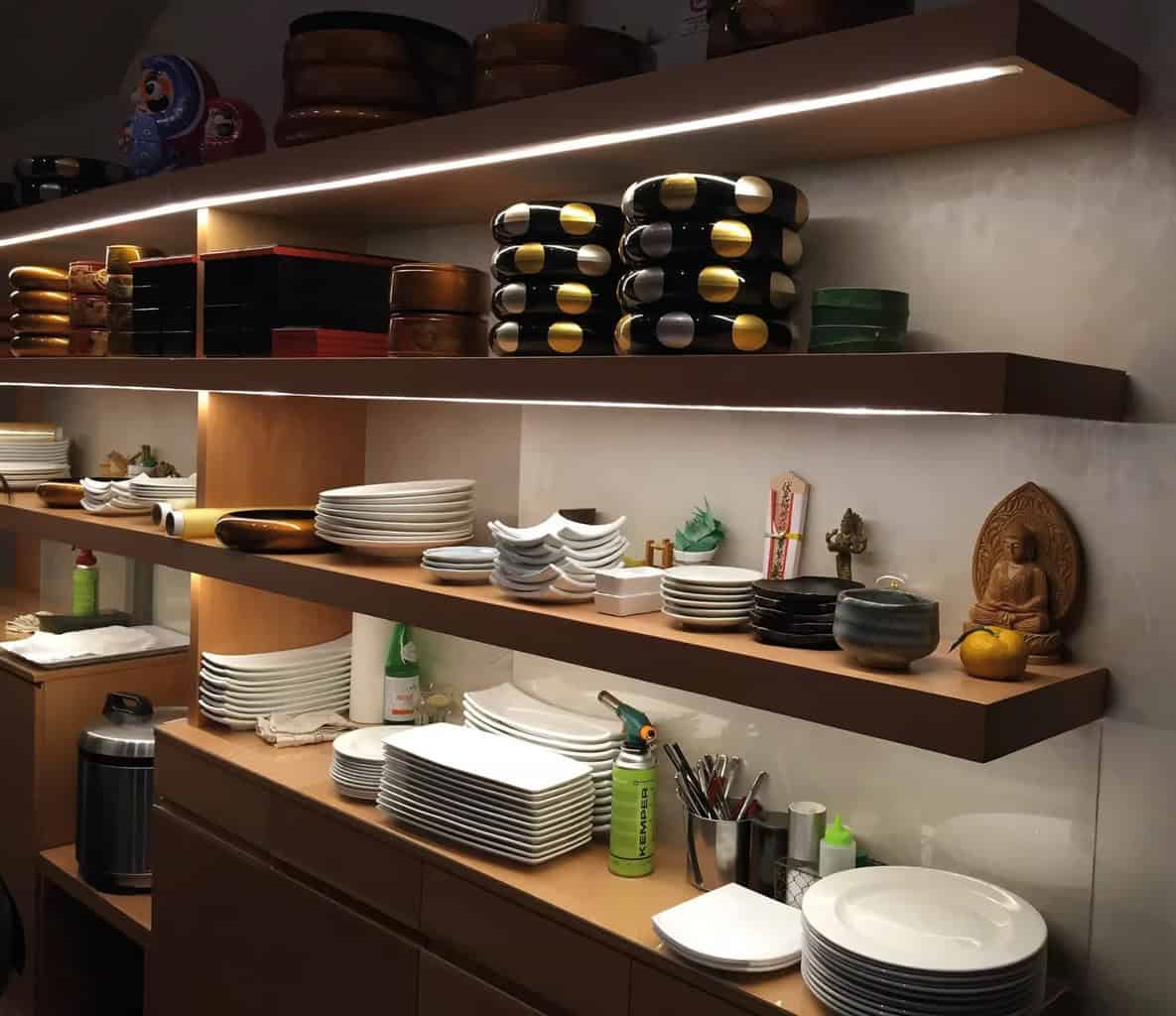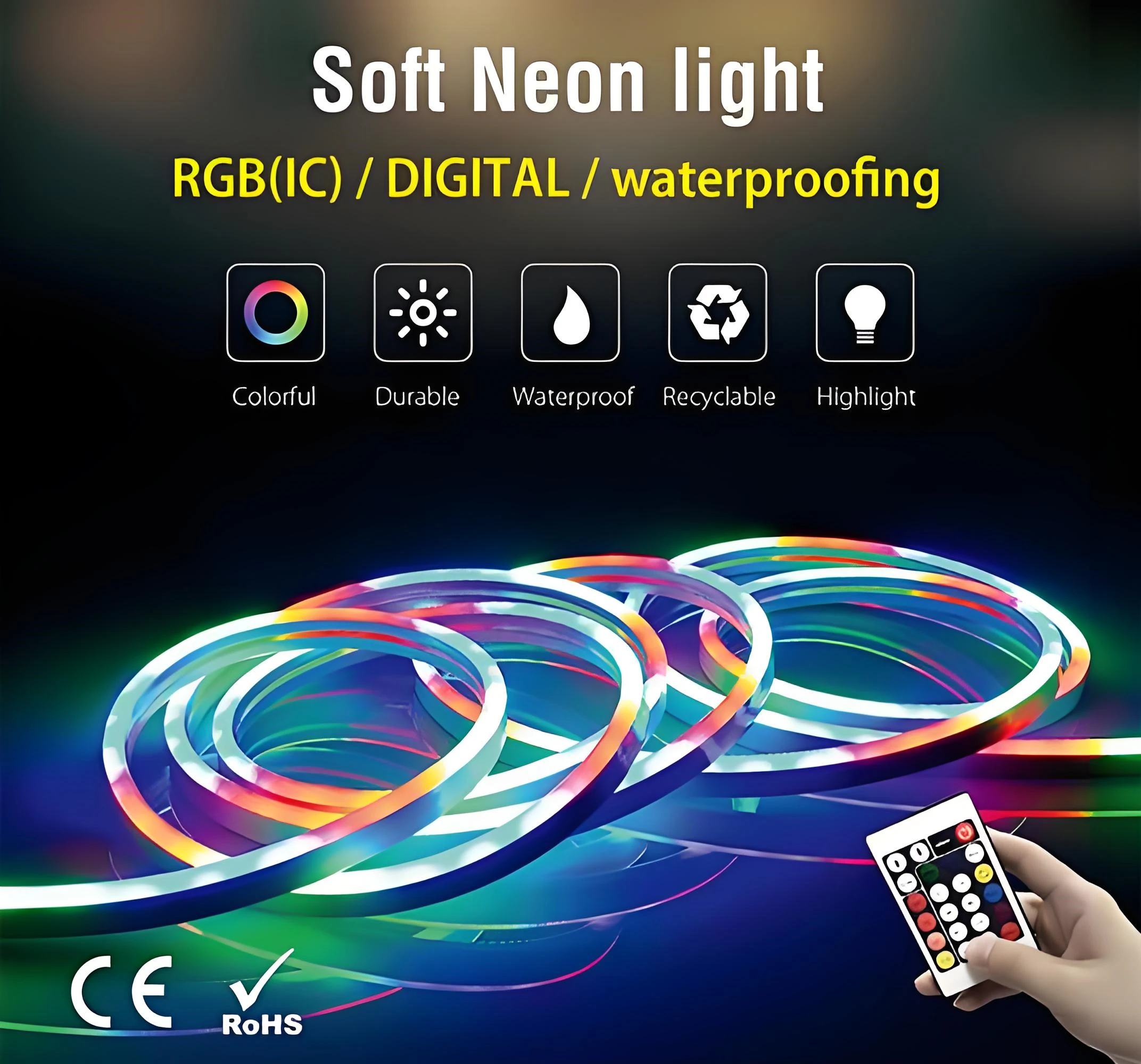In the dynamic and ever-innovative world of LED lighting, meeting customer demands for color consistency has become an essential aspect. Standard Deviation of Color Matching (SDCM) is a key metric that plays a critical role in ensuring color temperature uniformity in LED lighting solutions.
Imagine placing two LED lights of different hues side by side—would this inconsistent light color strike you as odd and visually uncomfortable? To avoid such failures in LED lighting, it is important to consider SDCM. It measures the consistency of light colors and ensures a uniform and flawless light output. In this article, we dive into all the information about SDCM for LED strips and choose the right LED strip for your project.
What is SDCM?
SDCM stands for “Standard Deviation of Color Matching.” SDCM is the official unit used in LED lighting to describe the deviation of light color from the McAdam’s ellipse to describe the color matching accuracy of a light source. The McDonald’s ellipse shows how much LED lighting in the same product family deviates from the standard in terms of color consistency.
The McAdam Ellipse was invented by scientist David McAdam. McAdam’s measurements show that all observer-made matches fall within the ellipse on the CIE 1931 chromaticity diagram. The measurements were taken at 25 points on the chromaticity diagram. Depending on the color tested, the size and orientation of the ellipses on the chart were found to vary considerably.
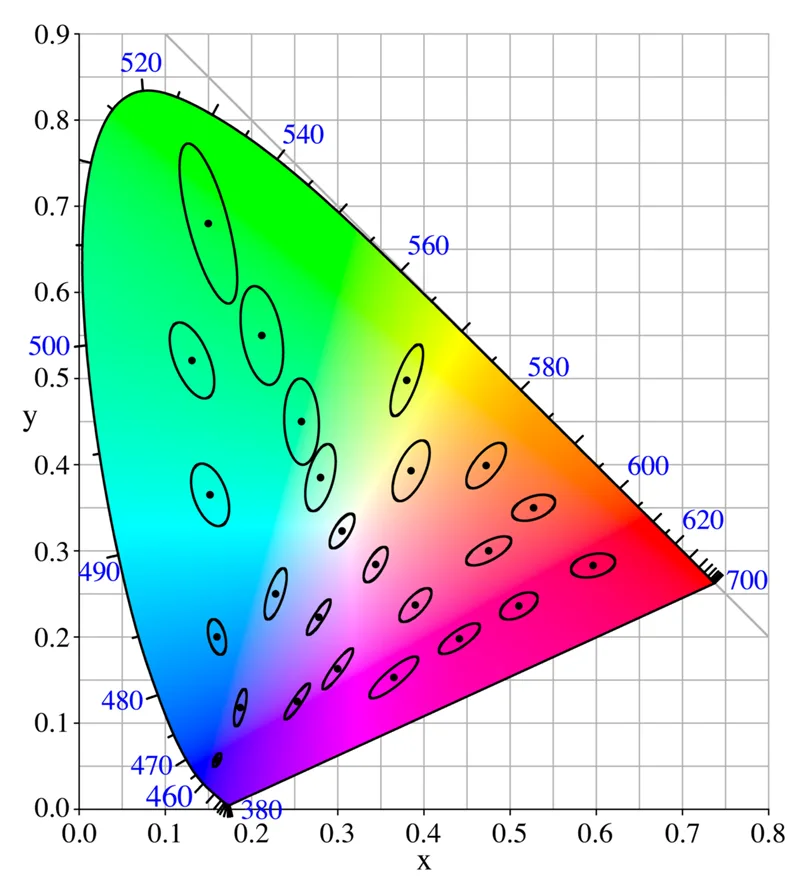
The 25 ellipses are shown on the chromaticity diagram above. MacAdam identified the color coordinates where 50% of the subjects observed a color difference and 50% of the subjects did not observe a color difference. This area appears to be elliptic. It is also called 1 SDCM (1 MacAdams ellipse). With the 2 SDCM deviation, the number of observed color differences will increase because the ellipse will double in size.
These steps describe different degrees of visibility. If there is a color difference within one step of the MacAdam ellipse, the human eye will not recognize it. Even with two or three steps (3 SDCM), the change is hardly noticeable. The ellipse shows that the color temperature deviation is gradual. The center of the ellipse indicates the ideal target value for the LED color temperature, and the edges indicate the permissible deviation for a particular “grade.”.
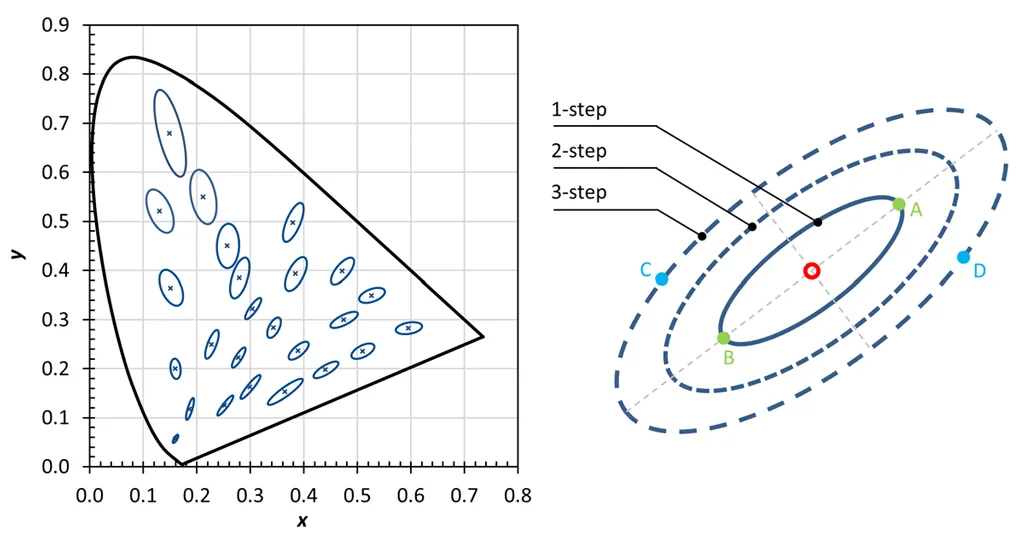
The table below provides an overview:
| Size MacAdams Ellipse | Visibility |
| 1 SDCM | Hardly any colour difference visible |
| 2 SDCM | Difference are visible only with instruments |
| 3 SDCM | Less colour difference visible |
| 4 SDCM | Colour difference visible |
| 5 SDCM | Marked difference visible |
The Importance of SDCM in LED Strips
For LED strips and lighting fixtures, lower SDCM values indicate better color consistency, which directly impacts the overall quality and performance of the product. High-quality LED strip lighting typically has a low SDCM value, which ensures consistent color temperature and hue throughout the length of the strip and from batch to batch. This is critical to creating a uniform and professional lighting environment.
- Color Consistency and Uniformity
A low SDCM is critical to maintaining color consistency. This ensures that light sources look the same. Therefore, when purchasing lighting for museums, art galleries, or similar applications where color consistency is important, look for low SDCM fixtures.
- Visual Comfort
Lights with high SDCM look very different when placed side by side. This type of lighting will naturally give any visitor the idea that the lights are set up incorrectly. This inconsistent lighting creates blinding problems and makes you feel uncomfortable. For this reason, it is important to use low SDCM lights for smooth, even illumination.
- Maintaining the Quality of LED Chips
Manufacturers use SDCM as a standard to keep the color of light consistent. As a result, all chips emitted are the same color. Therefore, due to the color consistency, the illumination of the LED strip looks flawless. Therefore, considering the SDCM value improves the quality of the final product.
- Long-term Performance
The color of a luminaire changes gradually over time. Therefore, when using high SDCM lamps, the change in light will be more noticeable. Conversely, if you use low SDCM lamps, you will minimize color change problems. As a result, you can use your fixtures for a long time without having to replace them.
Relationship Between SDCM and Other Color Indicators
While SDCM is primarily concerned with color consistency, it is closely related to other color indicators such as CCT (color temperature) and CRI (color rendering index). LED strips and luminaires with good SDCM values typically have consistent color temperature and high CRI, all of which contribute to overall lighting quality.
Relationship Between SDCM and CCT
CCT is a measure of white light hue in Kelvins; the higher the CCT, the cooler the light, and the lower the CCT, the warmer the light. However, even if you can determine the value of CCT, you can still find significant differences in light color. For example, a strip with a CCT of 3000K may appear green, warm white, or red. Even with these color differences, they are still called 3000K bulbs. Therefore, it can be said that CCT is basically a range of color temperatures in which the color temperature value fluctuates.
So, how do you identify the exact color of light? To detect the exact color of light, you need to consider the SDCM, and now let’s take an example:
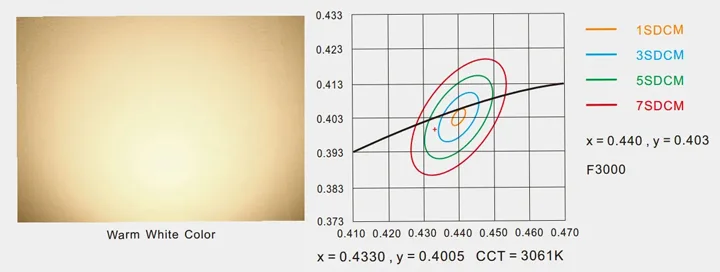
From the graph above, we can see that the warm white CCT = 3061K, which is within 5 SDCM of a standard light source, or SDCM < 5.
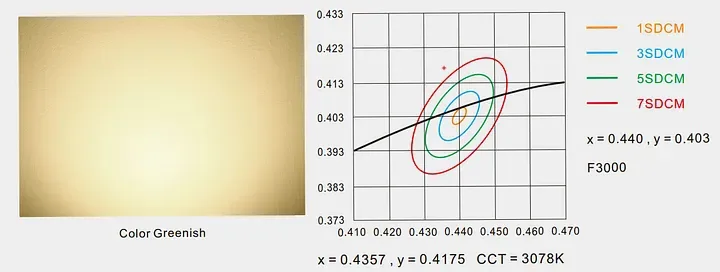
And in this graph, we see that the warm white CCT = 3078K, which is not much different from the 3061K color temperature value above. The SDCM between it and the standard 3000K is already outside of 5 SDCM, which is SDCM > 7, and the SDCM deviates too much. So there is already a color difference between them.
Relationship Between SDCM and CRI
CRI is another indicator related to light color. It determines the color accuracy of an object under artificial lighting. On a scale of 0 to 100, a higher CRI value (close to 100) means that the color reproduction is more natural. CRI reflects the quality of the color reproduction, not the consistency of the color across multiple light sources, which is where SDCM comes in.
SDCM determines the color shift of light compared to another target light source. Low SDCM means less color shift and similar color output. A high CRI source may still have a difference in appearance (if the SDCM values are significantly different), and the SDCM-assisted CRI ensures that the color is not only accurate but also consistent. As a result, LED strips with high CRI and low SDCM provide high-quality illumination.
The benefits of using these high CRI and low SDCM strips include the following:
- Higher color accuracy
- Color consistency and uniform illumination
- No glare problems and reduced eye fatigue
- Comfortable vision
In addition, high CRI and low SDCM LED strips are critical for commercial lighting. In retail stores, high CRI tape lights show customers the exact color of the product. Similarly, when shopping under low SDCM lights, you will get a comfortable and even light setting.
Relationship Between SDCM and Chromatic Aberration
Chromatic aberration is the difference in color, that is, the difference between the X and Y coordinate values of two light colors; the smaller the gap, the smaller the chromatic aberration.
SDCM is the difference between the X, Y value of the product and the X, Y value of the standard light source; the smaller the distance, the lower the SDCM.
Here is an example:

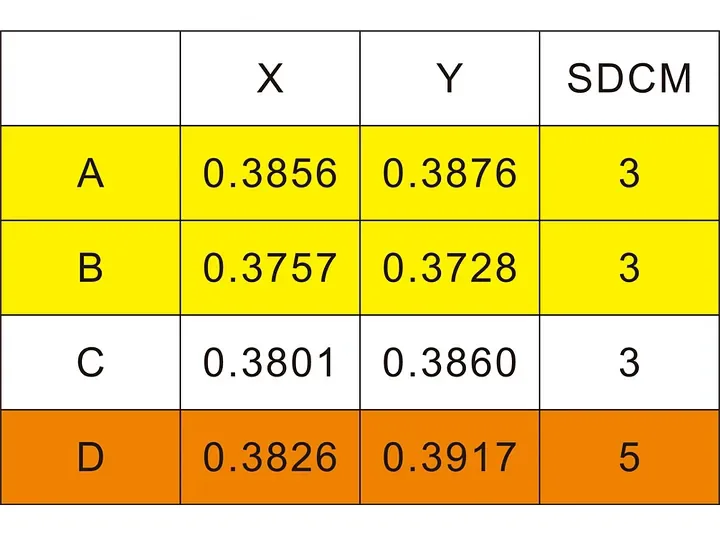
Sample A is 3 SDCM, B is 3 SDCM, and D is 5 SDCM, and subtracting the x-coordinate value of A from the x-coordinate value of B results in a result equal to +0.0099. By the same algorithm, the difference in the y-coordinate is equal to +0.0148, which means that the color difference for AB is (X = +0.0099, Y = +0.0148), and the color difference for AD is (X = +0.0030, Y = -0.0041).
It can be seen that the color difference between A and B is greater than the difference between A and D. However, the SDCM of A and B are equal; both are 3 SDCM, while the SDCM of A and D is 2, so the SDCM and color difference are different.
The figure below shows the color difference of light emitted by SDCM of 2 Step, 3 Stepr, 5 Step, and 7 Step at 3000K color temperature:
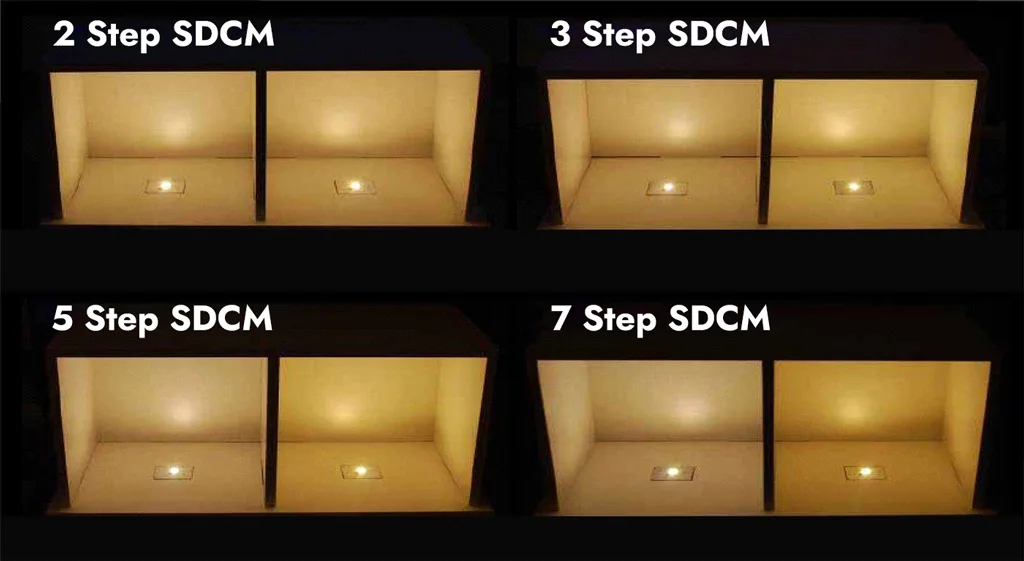
From the above comparison chart, it can be seen:
1. SDCM 2 Step human eyes basically cannot see the color difference; SDCM 3 Step color difference is smaller; 5 Step and 7 Step SDCM color difference is more obvious.
2. SDCM 3 Step is the critical value of human eye recognition.
The McAdam experiment proved that just perceived color difference and color matching standard deviation between the existence of a linear relationship, three times the standard deviation (i.e., the location of the three steps), is just perceived color difference. If the two color coordinates fall within the 2 step McAdam ellipse (i.e., within two steps), then the human eye can hardly see the difference between the two colors.
The difference between the color corresponding to the boundary of No. 3 McAdam’s ellipse and the center of No. 3 McAdam’s ellipse is the chromatic aberration detectable by the human eye, and the larger the SDCM is, the larger the chromatic aberration is.
Relationship Between SDCM and Duv
Duv stands for “Delta UV.” This is another metric for LED lights that indicates the variation between light color and pure white in the chromaticity diagram. This refers to whether the white light has a green or pink tint.
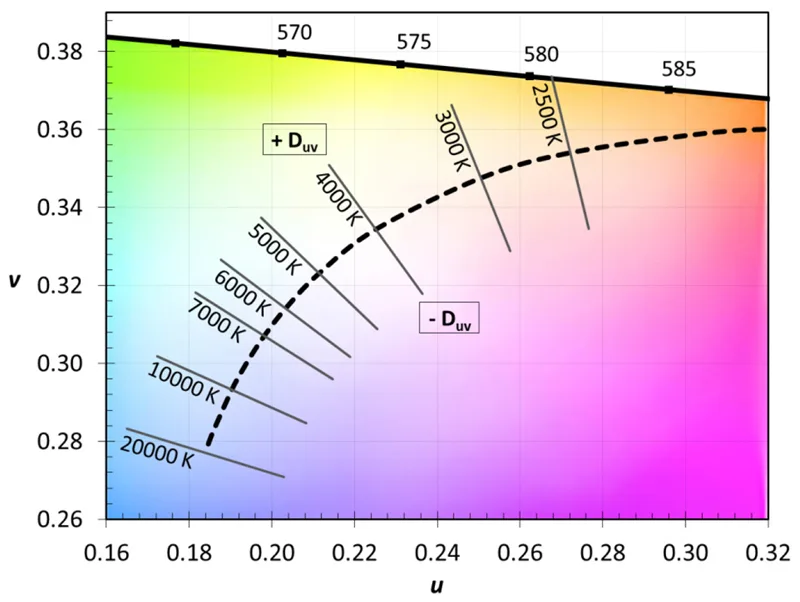
The value of Duv can be positive or negative, positive when the chromaticity point of the light source is above the Planck trace and negative when the chromaticity point of the light source is below the Planck trace. When the Duv value is above zero, it is called positive Duv. The light color looks cooler and has a greenish hue. Similarly, when Duv is below zero, the light appears to have a pinkish hue and is warm. Therefore, to be accurate, you should always choose zero Duv. This ensures that the color does not deviate from the desired CCT appearance.
Lamps with the same CCT and SDCM may look different due to different Duv values.
For example, let’s take two LEDs with 4000K CCT and SDCM 1. Let’s say that one light has a positive Duv of +0.003 and the other has a negative Duv of -0.003. Now, even though they have the same CCT and SDCM, the light with the positive Duv will appear green. At the same time, the light with negative Duv will appear a warmer pink color.
Therefore, it is important to consider the Duv value to keep the light consistent.
SDCM Standard for LED Industry
At present, there are three main types of international SDCM standards:
1. North American Energy Star Standard
Energy Star ANSI C78.376, color tolerance ≤ 7 SDCM, according to the LED characteristics.
| Color Temperature Range | ANSI C78.377 | |||||
| 3 Steps | Distance | 5 Steps | Distance | 7 Steps | Distance | |
| 2700K | 2670-2780K | 110 | 2630–2830K | 200 | 2580–2880K | 300 |
| 3000K | 2970–3120K | 150 | 2920–3170K | 250 | 2870–3220K | 350 |
| 3500K | 3360–3560K | 200 | 3300–3650K | 350 | 3230–3730K | 500 |
| 4000K | 3860–4110K | 250 | 3770–4220K | 450 | 3680–4330K | 650 |
| 5000K | 4860–5210K | 350 | 4750–5300K | 550 | 4650–5450K | 900 |
| 6500K | 6300–6800K | 500 | 6150–6950K | 800 | 6050–7150K | 1100 |
2. EU IEC Standard
EU standard ERP, color tolerance ≤ 6SDCM, according to the technical requirements to regulate the LED division area.
| Color Temperature Range | IEC 60081 | |||||
| 3 Steps | Distance | 5 Steps | Distance | 7 Steps | Distance | |
| 2700K | 2680-2790K | 110 | 2640–2840K | 200 | 2590–2890K | 300 |
| 3000K | 2865–3015K | 150 | 2820–3070K | 250 | 2770–3120K | 350 |
| 3500K | 3350–3550K | 200 | 3280–3630K | 350 | 3210–3710K | 500 |
| 4000K | 3910–4160K | 250 | 3820–4270K | 450 | 3740–4390K | 650 |
| 5000K | 4810–5160K | 350 | 4720–5270K | 550 | 4620–5420K | 900 |
| 6500K | 6200–6700K | 500 | 6100–6900K | 800 | 5950–7050K | 1100 |
3. Chinese National Standard
Chinese standard GB10682-2002, double-ended fluorescent lamp performance requirements for color tolerance ≤ 5 SDCM, can be used as a reference for the color tolerance of LED lamps.
Application of SDCM in Different LED Lighting
The importance of SDCM is especially prominent in certain applications, such as commercial lighting, museum displays, or high-end interior decoration. These scenarios require extremely high color consistency to ensure visual coherence and professionalism. Understanding and controlling SDCM values is therefore critical to the selection and use of high-quality LED strip and LED lighting fixtures, such as architectural lighting, retail and commercial spaces, as well as home and office lighting.
The common metrics we all compare when purchasing LED strips or any LED fixture are CCT and CRI, but the problem is that these two metrics alone will not ensure color consistency of the light. As we discussed in the example above, two LED strips with the same CCT may end up looking different due to the SDCM value. Therefore, to ensure color consistency, you have no choice but to skip the SDCM.
Indoor spaces, or applications that require accurate color maintenance, typically require less SDCM so that color consistency is ensured and the space is lit compactly. In general, indoor lighting is best served by using the first 3 SDCMs; however, in outdoor spaces, LED fixtures with more color derivatives are fine. You can choose 5 SDCM or higher depending on your lighting requirements.
| Application | Suggested SDCM |
| Art Galleries and Museums | 1-2 Step SDCM |
| Healthcare Facilities | 1-2 Step SDCM |
| Residential Spaces | 1-3 Step SDCM |
| Office Spaces | 3-4 Step SDCM |
| Manufacturing and Industrial | 4-5 Step SDCM |
| Outdoor Lighting | 5 or higher Step SDCM |
How to Test SDCM?
Typically, LED manufacturers use the SDCM standard to classify and select LED chips. By tightly controlling the SDCM values, they can produce LED lights with more consistent color. This sorting and selection process helps to improve the quality and consistency of the final product for a variety of applications.
Accurately measuring and controlling the SDCM value of finished LED lamps is a technical challenge. It requires specialized measurement equipment, stringent quality control processes, and reliable manufacturers. LED luminaire manufacturers are continually improving production techniques and test methods to achieve lower SDCM values and better color consistency.
The SDCM of an LED strip is tested using a large integrating sphere machine, which is connected to a spectrometer to determine the color consistency of the LED chips.
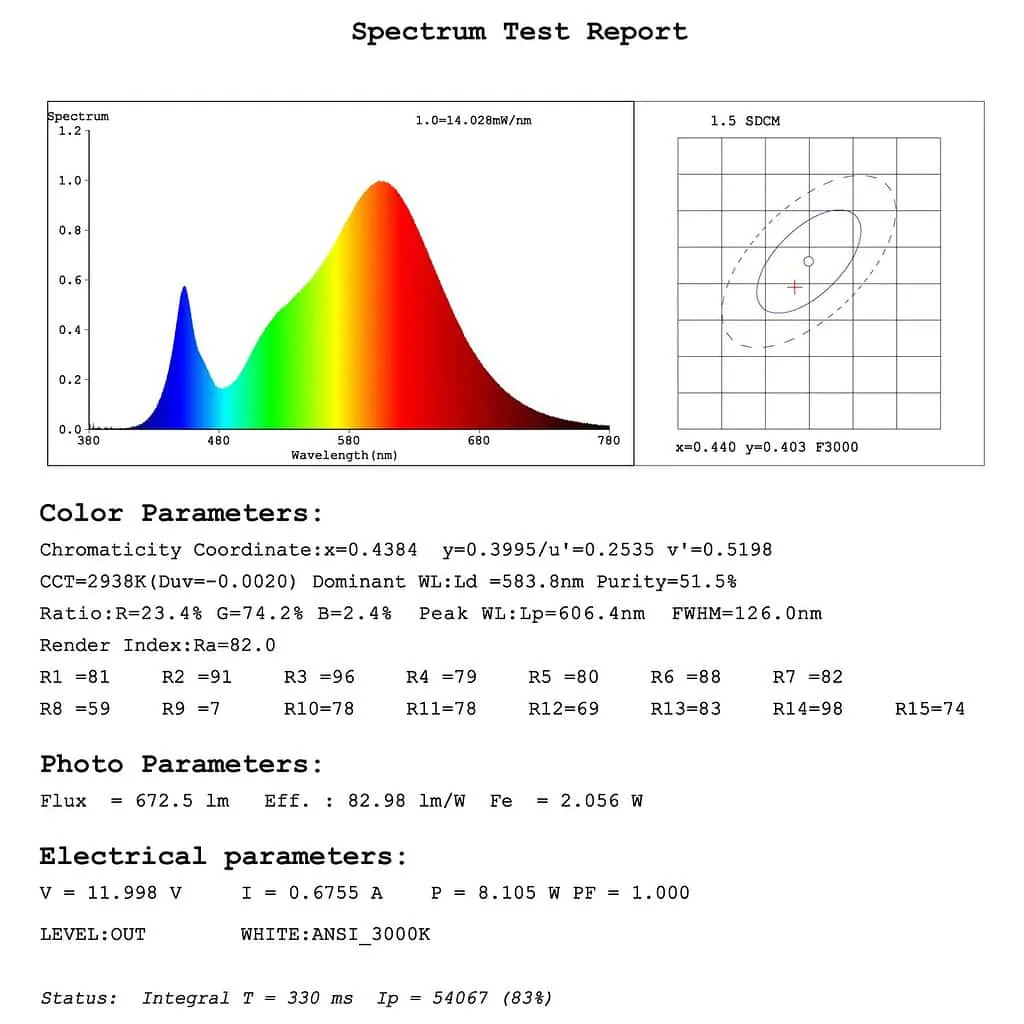
You can see the SDCM value for this lamp in the upper right corner of the test report, 1.5 SDCM. This is very close to the standard value.
Conclusion
SDCM has a direct and close relationship with color consistency; it provides a standardized way to measure and express color differences and can objectively compare the color consistency between different batches of LED products or different manufacturers. The lower the SDCM value, the higher the color consistency, which is especially important for applications requiring high-quality lighting effects.
For LED strips and lighting fixtures, lower SDCM values indicate better color consistency, which directly affects the overall quality and performance of the product. High-quality LED lighting typically has a low SDCM value, which ensures consistent color temperature and hue throughout the length of the strip and from batch to batch. This is critical to creating a uniform and professional lighting environment.
For lighting designers and end-users, understanding SDCM values can help make more informed product choices. It provides an objective standard for evaluating and comparing the color consistency of different LED strip products so that the most appropriate product can be selected for a particular application.
SDCM is an important matrix for ensuring color consistency between luminaires. However, you should always consider choosing the correct SDCM for your lamps and always use low SDCM lamps in the room. This will ensure even and consistent lighting throughout the room. In addition, purchase lamps from a reputable brand that tests for SDCM and maintains strict values.
